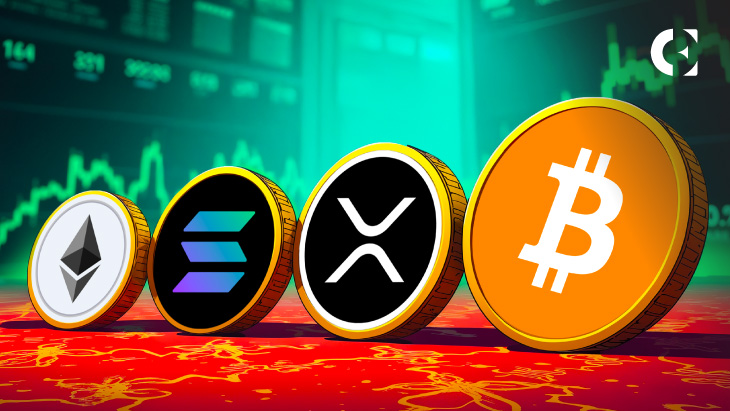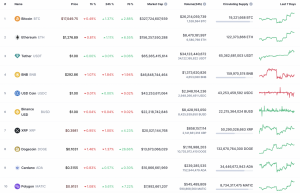Bitcoin Eth And Xrp A Comprehensive Analysis

With bitcoin eth and xrp leading the charge in the cryptocurrency space, exploring their unique dynamics is both fascinating and essential for understanding the future of digital finance. Each of these cryptocurrencies has carved out its own niche, driven by distinctive technological foundations and varied use cases that appeal to different segments of the market.
This analysis delves into the fundamental differences, market trends, applications, regulatory environments, and future prospects of Bitcoin, Ethereum, and XRP, providing insight into what sets them apart and how they interact within the ever-evolving crypto ecosystem.
Comparison of Bitcoin, Ethereum, and XRP
Bitcoin, Ethereum, and XRP are three of the most prominent cryptocurrencies in the market, each with unique characteristics and functionalities. Understanding their differences is essential for anyone looking to invest or engage with these digital assets.
Fundamental Differences
Bitcoin, the first cryptocurrency, primarily serves as a digital gold, offering a decentralized currency that is resistant to censorship. Ethereum, on the other hand, is a blockchain platform designed for creating decentralized applications (dApps) through smart contracts. XRP, created by Ripple, focuses on enabling fast and cost-effective cross-border payments.
| Cryptocurrency | Market Capitalization | Transaction Speed | Use Cases |
|---|---|---|---|
| Bitcoin | $400 billion | 10 minutes | Store of value, digital currency |
| Ethereum | $200 billion | 15 seconds | Smart contracts, dApps |
| XRP | $25 billion | 3-5 seconds | Cross-border payments, remittances |
The technological foundations of these cryptocurrencies also vary significantly. Bitcoin utilizes a Proof of Work (PoW) consensus mechanism, ensuring network security through computational power. Ethereum is transitioning to a Proof of Stake (PoS) model with Ethereum 2.0, aiming for scalability and energy efficiency. XRP employs a unique consensus algorithm that validates transactions through a network of trusted nodes, allowing for quick transaction confirmation.
Market Trends and Performance
Analyzing the historical price trends of Bitcoin, Ethereum, and XRP reveals interesting patterns and volatility. Over the past five years, Bitcoin has experienced several dramatic price swings, peaking in late 2021. Ethereum has similarly seen substantial growth, particularly due to the rise of decentralized finance (DeFi) applications. XRP, however, has faced legal challenges that have impacted its performance.
Price Trends

The price movements of these cryptocurrencies are often influenced by market events such as regulatory news, technological advancements, and overall market sentiment.
- Bitcoin reached an all-time high of nearly $65,000 in April 2021.
- Ethereum’s price surged from around $200 in early 2020 to over $4,000 in May 2021.
- XRP’s price was heavily impacted by the SEC lawsuit in late 2020, leading to significant volatility.
Significant milestones for each cryptocurrency include the following:
- Bitcoin: Launched in 2009 as the first decentralized cryptocurrency.
- Ethereum: Introduced smart contracts in 2015, paving the way for dApps.
- XRP: Ripple’s partnerships with banks and financial institutions to facilitate cross-border transactions.
Use Cases and Applications
Bitcoin, Ethereum, and XRP have distinct use cases that cater to different industries and needs. Bitcoin is often viewed as a digital store of value, while Ethereum powers a wide range of decentralized applications through its smart contract capabilities. XRP is primarily used for fast and cost-effective cross-border transactions.
Primary Use Cases
Each cryptocurrency plays a vital role in various sectors.
| Cryptocurrency | Applications | Real-World Implementations |
|---|---|---|
| Bitcoin | Store of value, peer-to-peer transactions | Companies accepting Bitcoin as payment, Bitcoin ATMs |
| Ethereum | Smart contracts, decentralized finance (DeFi) | DeFi platforms like Uniswap, NFT marketplaces |
| XRP | Cross-border payments, remittances | Partnerships with banks for money transfers |
The potential applications for these cryptocurrencies continue to grow, with each offering unique advantages in their respective domains.
Regulatory Environment
The regulatory landscape for Bitcoin, Ethereum, and XRP varies significantly across different countries and regions. Understanding these challenges is crucial for the adoption and future of these cryptocurrencies.
Regulatory Challenges
Bitcoin is generally accepted as a legitimate asset in many countries, though regulations vary. Ethereum faces similar recognition, particularly in jurisdictions embracing blockchain technology. XRP, however, has encountered significant hurdles due to its ongoing legal battle with the SEC, which has implications for its status as a security.
- The United States has been a mixed bag for cryptocurrencies, with some states welcoming them while others impose strict regulations.
- In the European Union, a more unified regulatory framework is emerging, promoting cryptocurrency innovation.
- Countries like China have banned cryptocurrencies entirely, impacting their global market presence.
Government policies continue to shape the landscape for these digital assets, influencing how they are perceived and utilized.
Future Prospects and Innovations

Looking ahead, Bitcoin, Ethereum, and XRP are poised for further developments and innovations that could significantly influence their market positions.
Future Developments
Technological advancements and upgrades are essential for the evolution of these cryptocurrencies.
- Bitcoin is exploring solutions like the Lightning Network to enhance transaction speed.
- Ethereum 2.0 aims to transition to PoS, improving scalability and energy consumption.
- XRP is focusing on expanding its partnerships and enhancing its network’s efficiency.
With numerous features and upgrades planned, these cryptocurrencies are likely to continue evolving and attracting attention from investors and users alike.
Community and Ecosystem
The communities that support Bitcoin, Ethereum, and XRP play a crucial role in their growth and adoption. Each cryptocurrency boasts a vibrant ecosystem of developers, influencers, and enthusiasts.
Community Engagement
Community involvement is vital for the success of these digital assets.
- Bitcoin’s community is driven by a strong ethos of decentralization and financial independence.
- Ethereum’s developer community is among the largest, fostering innovation through hackathons and forums.
- XRP’s ecosystem is supported by Ripple and its various partnerships with financial institutions.
Various platforms and events serve as gathering points for enthusiasts and developers, promoting collaboration and knowledge sharing across these vibrant communities.
Summary

In wrapping up our exploration of bitcoin eth and xrp, it’s clear that while they share the same digital currency umbrella, each brings its own unique value to the world of finance. Understanding their differences and potential can guide investors, developers, and enthusiasts alike in navigating the complexities of cryptocurrency.
Helpful Answers
What is the main purpose of Bitcoin?
Bitcoin primarily serves as a decentralized digital currency designed for secure peer-to-peer transactions without the need for intermediaries.
How does Ethereum differ from Bitcoin?
Ethereum is not only a cryptocurrency but also a platform that enables the creation of smart contracts and decentralized applications (dApps).
What is XRP used for?
XRP is designed for fast and low-cost international money transfers, primarily used by financial institutions for cross-border transactions.
Are Bitcoin and Ethereum regulated?
Yes, both Bitcoin and Ethereum face varying degrees of regulation depending on the jurisdiction, impacting their adoption and use.
What are some future trends for these cryptocurrencies?
Future trends may include increased institutional adoption, advancements in technology like layer 2 solutions, and evolving regulatory landscapes.



